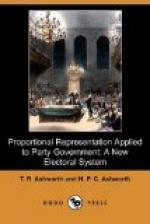The above facts furnish a complete answer to the arguments advanced by Mr. J.W. M’Cay, ex-M.L.A., in a series of articles in the Age against the application of proportional representation to the Federal Senate. While apparently recognizing that it is utterly impossible for the minority to secure a majority of the representation, he based his objection solely on the fact that a minority is able with electorates containing an even number of seats to secure one-half of the representation, and thus lead to what he terms “the minority block.”
The force of the objection will entirely depend on the size of the minority which is able thus to thwart the will of the majority. The Federal Senate will consist of 36 senators, each of the original States contributing six. No reasonable man would complain if the minority, being only entitled to 17 senators, actually returned 18, but Mr. M’Cay points out that it is possible for a minority entitled to 15 senators to return 18. To bring about this result he makes the absurd assumption that in each of the six States the minority polls exactly two whole units of representation, and a bare majority of a third unit. It is safe to say that this would not happen once in a thousand years. If the relative proportions of the two parties vary in the slightest in the different States some must be under and some over the assumed proportion. It is most probable that it will be under it in three States and over it in the other three States; and, under these circumstances, the party will return 15 senators, the exact number to which it is entitled. It may happen to be under the assumed proportion in only two of the States and over in the other four, and that the party will get one more senator than it is entitled to; but it is extremely improbable that it will get two more, and virtually impossible that it will get three more senators than its just proportion. Mr. M’Cay’s conclusion that proportional representation can only be used in electorates returning an odd number of representatives is shown to be entirely unwarranted. Equally fallacious is Professor Nanson’s rebutting statement that “scientific proportionalists recommend odd electorates.” While the number of States remains even, the mathematical chance of a minority securing one-half of the representation is precisely the same whether the States return an odd or an even number of senators. As a matter of fact, the danger of a minority securing one-half of the representation is much greater at the intermediate elections for the Senate, when each State returns three senators, the reason being the smaller field.




